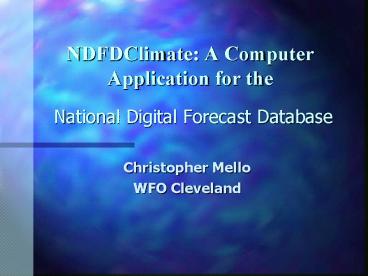NDFDClimate: A Computer Application for the National Digital Forecast Database - PowerPoint PPT Presentation
1 / 17
Title:
NDFDClimate: A Computer Application for the National Digital Forecast Database
Description:
Parameter-elevation Regressions on Independent Slopes Model ... Temperature data from PRISM consist of daily maximum and minimum temp fields for ... – PowerPoint PPT presentation
Number of Views:27
Avg rating:3.0/5.0
Title: NDFDClimate: A Computer Application for the National Digital Forecast Database
1
NDFDClimate A Computer Application for the
National Digital Forecast Database
- Christopher Mello
- WFO Cleveland
2
NDFDClimate
- NDFDClimate is a computer application that
creates images of forecast and climatological
parameters for the U.S. from two different
digital data sets. - NDFD (National Digital Forecast Database)
weather forecast grids produced by the NWS and
PRISM data (Parameter-elevation Regressions on
Independent Slopes Model), an expert system that
uses point climatological temperature data and a
digital elevation model (DEM) to generate gridded
estimates of climate parameters.
3
PRISM DataParameter-elevation Regressions on
Independent Slopes Model
- PRISM system determines climate elements (temp,
or rainfall) values at grid cells by calculating
linear regression relationships between the
climate element and elevation - Each grid cell estimate is determined from a
separate multiple linear regression using data
from nearby climate stations - Each station in the regression is weighted based
on five factors distance, elevation, vertical
layer (helps identify temp inversions in high
mountain valleys), topographic orientation,
coastal proximity
4
PRISM DataParameter-elevation Regressions on
Independent Slopes Model
- Temperature data from PRISM consist of daily
maximum and minimum temp fields for 1971 2000
at 5 km resolution - PRISM derived daily normal max min temperature
grids were compared to official data from the
NCDC for CLE, TOL, ERI, YNG, SYR, RIC, GSP - Each site had a MAE near 0.25 F for both max and
min temp with the highest daily error lt 1 F
5
NDFD DataNational Digital Forecast Database
- NDFD consists of digital forecast data that are
produced by the WFOs across the U.S. and merged
into a single image or file for each parameter
and projection. - Forecast grids are produced for Days 1-7 with 5
km resolution - NDFD grids include max and min temp, POP, temp,
water equivalent, snow amount
6
NDFDClimate
- NDFDClimate uses the GRADS software to create
images that utilize information from both the
NDFD and PRISM data - GRADS has the ability to add, subtract, or
manipulate fields using many formulas. Users can
specify the domain and contour interval of images.
7
NDFDClimate
- NDFDClimate produces temperature anomaly grids by
subtracting NDFD grids from PRISM derived daily
climate grids - NDFDClimate combines some NDFD fields to generate
5 day totals of heating and cooling degree days
and 60 hour QPF
8
NDFD Low Temp Fcst
9
Normal Low Temp 0909
10
Min Temp Anomaly 0909
11
Max Temp Anomaly
12
NDFD 5day Total CDD F
13
(No Transcript)
14
(No Transcript)
15
(No Transcript)
16
NDFDClimate Uses
- Processes NDFD data for users with 5 day HDD
CDD totals temp changes - Educate users on current temperatures anomalies
where point data may be inadequate
17
NDFDClimate
- References
- Berman, F., A. Chien, K. Cooper, J. Dogarra, I.
Foster, D. Gannon, L. Johnson, K. Kennedy, C.
Kesselman, J. Mellor-Crummey, D. Reed, L.
Torczon, and R. Wolski., 2002. The GRADS Project
Software Support for High-Level Grid Application
Development. International Journal of High
Performance Computing Applications, 15 327-344. - Daly, C., R.P. Neilson, and D. L. Phillips,
1994. A Statistical-Topographic Model for
Mapping Climatological Precipitation over
Mountainous Terrain. J. Appl. Meteor., 33,
140-158

